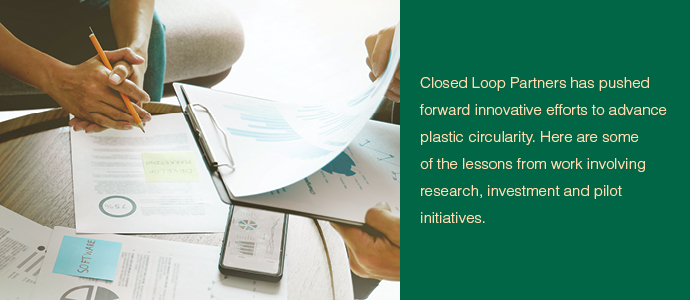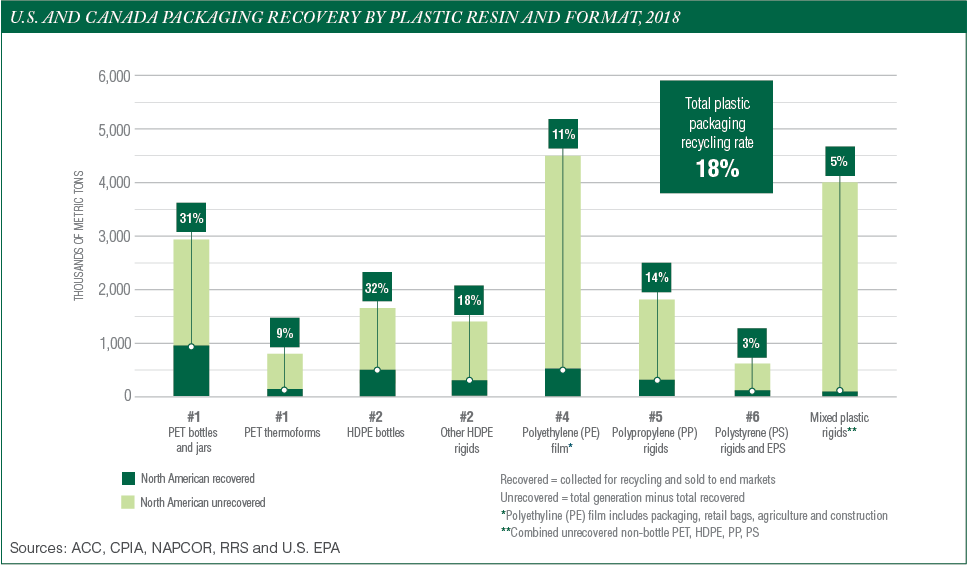
This article appeared in the April 2021 issue of Resource Recycling. Subscribe today for access to all print content.
Plastic pollution is one of the biggest environmental and social issues of our generation. The diverse chemistries and formats of plastics in our system – from packaging to textiles to wind turbines – mean there is no easy solution to recover these complex materials and keep them out of landfills, incinerators and waterways.
A circular system for plastics is one that is consciously designed to use fewer materials in the production and delivery of products and keeps materials in circulation at their highest value for as many generations as possible. Transitioning from our current linear system to a circular one will require a multi-strategy approach.
First and foremost, we must reduce the need for virgin plastic production by scaling reuse models and harnessing design innovation and alternative materials. Second, to address existing plastic waste, we will need to increase investment in modernizing mechanical recycling and deploy “advanced plastics recycling” technologies that can safely transform hard-to-recycle plastic waste into valuable new products or into building blocks to make new plastic or packaging. Advanced recycling includes chemical recycling – that is, catalytic, thermal processes – as well as biological and even sound-based technology processes which all purify or break down plastic to create high-quality outputs that can be reused in the system.
Over the last five years, Closed Loop Partners has researched, invested in and piloted numerous solutions as part of a multi-strategy approach to addressing the global plastics waste crisis, knowing that it’s a very complex puzzle to solve.
This article offers reflections on the latest learnings from across our initiatives.
You can’t improve what you don’t measure
Today, there is a radical mismatch between supply and demand for recycled plastics. We are recycling a mere 9% of plastics overall, and the current supply of recycled plastics meets only 6% of demand for the most common plastics in the U.S. and Canada (this is due largely to technical and market barriers).
The first step in closing the massive gap between where we are and where we need to be is to map and measure material volumes and flows.
Last year, Closed Loop Partners released the “U.S. and Canada Recycling Infrastructure and Plastic Waste Map” in an effort to increase the transparency of plastic supply chains. Our team found 11.5 million metric tons of plastic packaging are sent to landfills annually. Only 18% of packaging is currently recaptured by the recycling system with less than 5% of recycled content flowing back to packaging uses.
The map breaks down the volumes of plastics by resin and format and the flows by country, state and province, overlaying the existing recycling infrastructure across both the U.S. and Canada. This open-source, publicly accessible tool helps pinpoint the opportunities to recapture valuable plastics and re-incorporate them into manufacturing supply chains, highlighting key focus areas for effective interventions.
In the future, our team hopes to work with diverse industry groups to collect data and build out additional datasets to map other critical plastic waste flows beyond packaging, including textiles, electronics and health care plastics. Enhancing the transparency of supply chains and better understanding the current flow of materials are essential first steps to improve plastics recovery.
Reuse models are critical but need a blueprint to scale
Models for material reuse extend the life span of valuable materials in our economy, reducing the need for additional production of packaging. And technological advancements are ushering in a new generation of these models, which go beyond the “milkman style” delivery and harness state-of-the-art technology to create smart systems that provide transparency for the user and producer.
However, to truly move away from only niche eco-friendly customer adoption and to scale within larger retailers, continued testing and on-the-ground experimentation is needed.
In 2020, our NextGen Consortium in partnership with Starbucks, McDonald’s and others piloted several reusable cup models at cafes in the San Francisco area, examining every step of the reusable cup journey, from customer sign-up to the payment process to cup returns.
We observed first-hand the process of integrating these new systems into daily life both from a customer standpoint and a retailer’s perspective, finding, for example, that customer satisfaction was higher when there was a lost cup fee rather than an upfront deposit, and that businesses were better prepared for scale if they identified off-site, industrial-grade washing partners to collaborate with.
COVID-19 further emphasized the importance of sanitation and health, as well as the critical need to communicate these protections effectively to customers.
Meanwhile, through our Consortium to Reinvent the Retail Bag, which aims to identify, pilot and implement viable design solutions and models that are more sustainable than the current single-use retail bag, we continue to explore diverse reuse models. After our global solution search received more than 450 ideas to reinvent the retail bag, we’ve created a shortlist of 58 solutions, of which there are a number of reusable packaging applications.
Finally, Chile-based Algramo, a Closed Loop Partners portfolio company, entered the North American market in 2020 via a New York City pilot of its tech-enabled refill system which dispenses cleaning products. Through the project, we’re learning that adoption rates are high and fast when the sustainable option is also the cheaper and convenient option.
Algramo came into existence to solve a problem impacting millions of low-income families: the “poverty tax.” This market failure occurs when low-income families buy products in small formats and pay up to 40% more as a result.
Experimentation and piloting of new reuse models is critical to avoid any unintended consequences of introducing new systems. And in order to achieve industry impact, we’re committed to sharing the lessons learned and creating a blueprint to encourage collaboration and enable the growth of reuse models.
Closed Loop Partners took a step toward this earlier this year, releasing its “Bringing Reusable Packaging Systems to Life” report to provide an open-source resource with key steps for implementing reuse models.
Much to consider on compostable plastics
As companies deploy strategies to reduce, reuse and recycle plastics in their products and packaging, many are exploring bio-based plastics, biopolymers and compostable packaging alternatives.
Given the growth in this area, Closed Loop Partners released a report, “Navigating Plastic Alternatives in a Circular Economy,” to dispel some of the myths around compostable packaging, acknowledging that we’re in a phase of contradiction, experimentation and trade-offs, alongside progress and advances, as we chart a new course.
Transitioning toward plastic alternatives plays a very specific role as one line of defense against waste – after reduction and reuse – and in the context of organics, the practice should only be deployed in certain formats and contexts to drive value to organics processors.
Currently, we lack sufficient composting infrastructure to meet the growth in volume of compostable packaging. There is a critical need to address the misalignment between production and end-of-life to ensure even higher volumes of compostable packaging don’t end up in landfill.
Closed Loop Partners is continuing its work in this area with the launch of its Compostable Packaging Consortium, a pre-competitive collaboration that will create a framework for making informed decisions for when to deploy reusable, recyclable or compostable packaging, while also building an investment roadmap to scale the composting infrastructure needed to handle these formats.
Technology to expand scope of recovery
In 2020, we continued to evaluate the diverse landscape of advanced and chemical recycling technologies, partnering with many leading companies in the space to better understand their business models and technology processes.
While the official release of our findings won’t come until later this year, we continue to see how these technologies have the potential to expand the scope of plastics that can be recycled today. Currently, apparel, health care plastics and bulky rigids do not have any robust end-of-life recovery solutions, but they are viable feedstock for various advanced and chemical recycling technologies.
Industry, investors and policymakers must invest in the solutions that offer the biggest environmental benefits and scale those that can add value to the overall recycling system. The technology processes themselves do not determine whether a company or a process is “circular,” but rather the stakeholders invested in creating circular systems do.
Because the sector is newly developing, all stakeholders – brands, retailers, investors, plastic producers and recyclers, NGOs and citizens – have the opportunity and a role to play to ensure a safe and circular system and future.
Time to put the pieces together
Strategies to address plastic waste must be complementary – taken alone, they will be ineffective at producing a circular system for plastics. Continued testing, collaboration, collective learning and iterating is needed to pave the pathway forward.
As shown, many of the innovations needed to transition to a more circular system already exist. It’s now a question of a methodical, thoughtful implementation plan. This will require getting the right kind of investment, partnership and policy levers in place to catalyze the shift toward circularity.
Paula Luu is a director at the Center for the Circular Economy at Closed Loop Partners and can be contacted at [email protected]. Georgia Sherwin is the group’s director of communications and strategic initiatives and can be contacted at [email protected].
If you’re interested in learning more about Closed Loop Partners’ Advancing Circular Systems for Plastics Initiative as well as the group’s continued research, investment and piloting in this space, please get in touch with [email protected].


